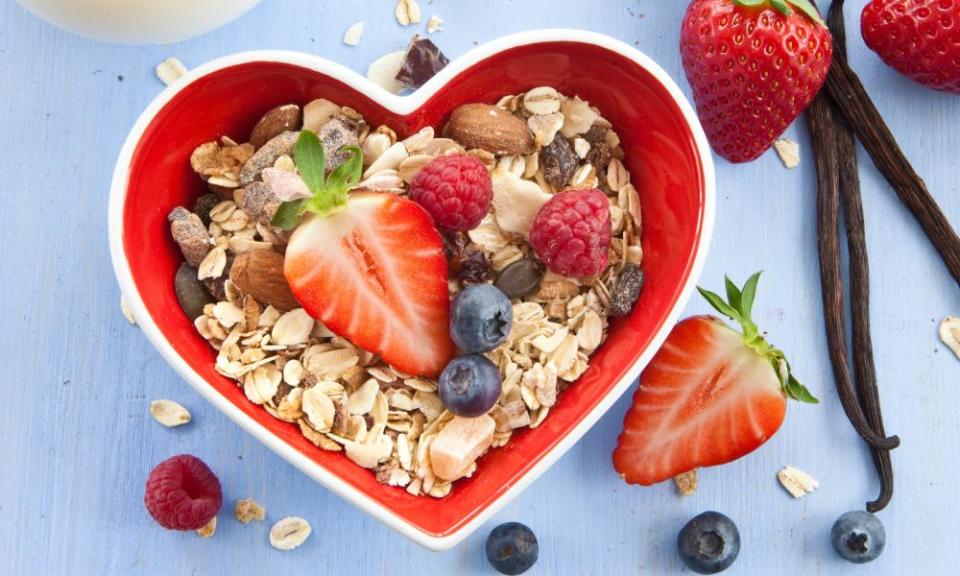Think you’re too smart to be taken in by silly food labels? Think again

I feel it in my fingers. I feel it in my toes. Love is all around me. But it shouldn’t be in granola bowls. So says the US Food and Drug Administration, anyway – albeit slightly more drily. The FDA recently warned a Massachusetts-based bakery that it can’t list “love” as an ingredient in its granola, sternly explaining that love isn’t a recognised ingredient, “and is considered to be intervening material”. Which is FDA-speak for extraneous information liable to distract consumers from a product’s legitimate ingredient list, thus tricking them into eating suboptimal granola for breakfast. I, for one, hate it when that happens.
It should be noted that the FDA didn’t censure a small business just because of a little lighthearted labelling. No, it seems there was so much love in the Nashoba Brook Bakery that things had started to get pretty filthy in the kitchen. The FDA’s warning letter lists numerous infractions, including bugs on the brioche and a “one-inch-long crawling insect” by the focaccia.
Nevertheless, the consumer watchdog does seem to have been rather heavy-handed in its condemnation; after all, one person’s crawling insect is another person’s extra protein. And objections to listing love as an ingredient are rather ridiculous when you consider the general state of food labelling, which is already extremely dubious and incredibly confusing. While you don’t need to be a genius to realise you can’t actually bottle love and bake it into granola, assessing the accuracy and importance of some of the more scientific-sounding food labels today can be very difficult.
It has become impossible to stand in a supermarket aisle without facing a barrage of bombast and confusing claims of “natural”, “fresh”, “organic”, “super” this and “unprocessed” that. Not to mention the ever-expanding variety of “free-from” formulations. Indeed, last year Sainsbury’s almost doubled the number of products in its own Freefrom range and, according to Euromonitor, the global “free-from” category increased by 6.8% in 2016 to $32bn (£24.5bn) in retail value.
Now, the increase in “free-from” food labelling isn’t just marketing gone mad; it seems to reflect an increase in the prevalence of food allergies in western countries. A recent study by the US nonprofit Fair Health found an almost 400% increase in life-threatening allergic reactions to food between 2007 and 2016, based on an analysis of private insurance claims. In the UK, hospital admissions for children with food allergies increased by 700% between 1990 and 2007.
But while food allergies are undoubtedly on the rise, this doesn’t entirely explain the recent surge in popularity of foods claiming to be free from glucose, lactose et al. According to research by the Grocer, “a shopper’s decision to dodge dairy, gluten and other potential allergens often has nothing to do with medical need”. Rather, large numbers of people are buying this stuff because they think it will improve their health. Further, while there has been a documented increase in certain food allergies (particularly peanuts), there is little evidence that more people are becoming gluten-intolerant.
Nevertheless, “gluten-free” has become one of the most popular trends. In 2016, global sales of gluten-free food increased by 12.6% to $3.5bn, compared with overall packaged foods’ growth of just over 4% – suggesting companies are cheerfully cashing in on consumer ignorance of what gluten actually is. Indeed, the gluten-free trend has got so out of hand, you can even buy gluten-free water. Should it be worth pointing out, let’s remember: all water is already, and always has been, gluten-free.
There seems to be a widespread perception that gluten-free is synonymous with healthy, but the opposite is often true. Earlier this year, experts found that eating a gluten-free diet when you don’t have coeliac disease can increase the risk of obesity, as gluten-free substitutes are often higher in fat and lower in protein than the original. And recent research published in the BMJ asserts that unnecessarily avoiding gluten could increase your risk of heart disease.
At this point, it’s possible you may be smugly thinking that you’re far too smart to be taken in by silly food labels. Sorry, but research implies otherwise. A study from the University of North Carolina and Duke University suggests that people with higher levels of education and income are more likely to be swayed by low-content food claims. And this has serious consequences: food labels exert considerable influence. To begin with, they can make us eat more of the wrong things. There is plenty of evidence that when a food is perceived as healthy, people are more likely to eat more of it.
Further, food labels can affect the release of ghrelin in our bodies. Ghrelin is commonly known as the “hunger hormone”, and is responsible for telling your brain that you feel hungry. When ghrelin levels rise, your metabolism slows down, just in case you don’t find any food. A 2011 study, Mind Over Milkshakes, found that when people drank a milkshake they thought was highly calorific, their ghrelin levels dropped about three times more than when they thought they were drinking a shake advertised as being zero fat, zero added sugar and low calorie. Which is a reminder that we all ought to be highly sceptical of the claims on our food, worry about how these claims affect us and press for more policing of misleading labelling.
Finally, science suggests that all this thinking about food is probably making you hungry. If you’re off in search of a sustaining snack, please, don’t be afraid of gluten. However, you might want to try to find something that is fad-free.

 Yahoo News
Yahoo News 